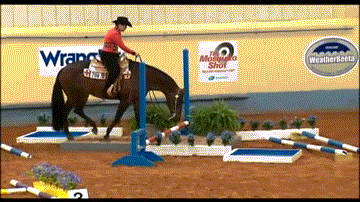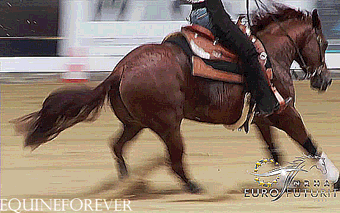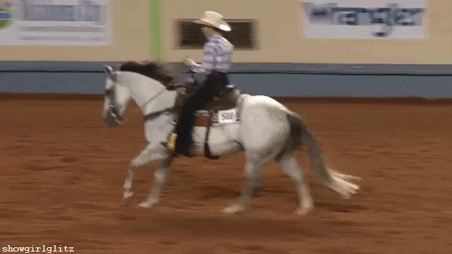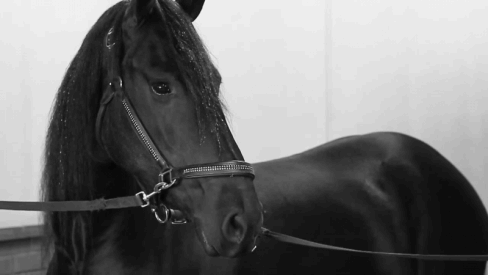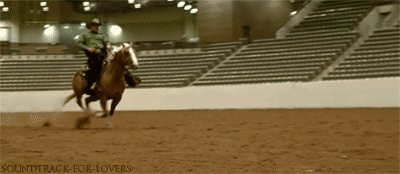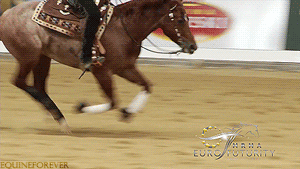|
|
Post by TWiZTiD ☣ on Jan 13, 2015 9:21:38 GMT -5
BASICS COLORS;; BAY Body color ranges from a light reddish-brown to very dark brown with "black points". (Points refer to the mane, tail, and lower legs.)
Dark bay: very dark red or brown hair, difficult to distinguish from seal brown. Sometimes also called "black bay", "mahogany bay", or "brown".
Blood bay: bright red hair; often considered simply "bay".
Brown: The word "brown" is used by some breed registries to describe dark bays. There is a distinct allele that darkens a bay coat to seal brown (At), but it is not the cause of all forms of dark bay. Informally, "brown" is applied to many distinct coat colors. Most often, horses described by casual observers as "brown" are actually bay or chestnut. In the absence of DNA testing, chestnut and bay can be distinguished from each other by looking at the mane, tail and legs for the presence of black points.
EXAMPLES: --- Seal Bay--- Mahogany BayDark BayBlood BayBrownCHESTNUT A reddish body color with no black. Mane and tail are the same shade or lighter than the body coat.
Liver chestnut: very dark brown coat. Sometimes a liver chestnut is also simply called "brown".
Sorrel: Reddish-tan to red coat, about the color of a new penny. The most common shade of chestnut.
Blond or light chestnut: seldom-used term for lighter tan coat with pale mane and tail that is not quite a dun.
EXAMPLES: Liver Chestnut--- Flaxen Liver Chestnut--- Flaxen ChestnutSorrelLight ChestnutGRAY A horse with black skin but white or mixed dark and white hairs. Gray horses can be born any color, and lighten as they age. Most will eventually gray out to either a complete white or a "fleabitten" hair coat. Most "white" horses are actually grays with a fully white hair coat. A gray horse is distinguished from a white horse by dark skin, particularly noticeable around the eyes, muzzle, flanks, and other areas of thin or no hair.
Salt and Pepper or "steel" gray: Usually a younger horse, an animal with white and dark hairs evenly intermixed over most of the body.
Dapple gray: a dark-colored horse with lighter rings of graying hairs, called dapples, scattered throughout.
Fleabitten gray: an otherwise fully white-haired horse that develops red hairs flecked throughout the coat.
Rose gray: a gray horse with a reddish or pinkish tinge to its coat. This color occurs with a horse born bay or chestnut while the young horse is "graying out".
EXAMPLES ::Steel GrayDapple GrayFleabitten GrayRose GrayBLACK Black is relatively uncommon, though it is not "rare". There are two types of black, fading black and non-fading black. Most black horses will fade to a brownish color if the horse is exposed to sunlight on a regular basis. Non-fading black is a blue-black shade that does not fade in the sun. Genetically, the two cannot yet be differentiated, and some claim the difference occurs due to management rather than genetics, though this claim is hotly disputed. Most black foals are usually born a mousy grey or dun color. As their foal coat begins to shed out, their black color will show through, though in some breeds black foals are born jet black. For a horse to be considered black, it must be completely black except for white markings. A sun-bleached black horse is still black, even though it may appear to be a dark bay or brown. A visible difference between a true black and a dark chestnut or bay is seen in the fine hairs around the eyes and muzzle; on a true black these hairs are black, even if the horse is sun-bleached, on other colors, they will be lighter.
|
|
|
|
Post by TWiZTiD ☣ on Jan 13, 2015 9:50:07 GMT -5
DILUTION COLORS;;
DUN Yellowish or tan coat with primitive markings, sometimes called "dun factors": a darker-colored mane and tail, a dorsal stripe along the back and occasionally faint horizontal zebra stripings on the upper legs and a possible transverse stripe across the withers.
Grullo, Grulla, or Blue Dun: A horse with a black base color and the dun gene. Coat is solid "mouse-colored" gray or silver (can also be almost brownish-gray) with black or dark gray primitive markings.
Red dun: A chestnut base coat with dun factors. Coat is usually pale yellow or tan with chestnut (red) primitive markings.
"Bay dun" or "Zebra dun" are terms sometimes used to describe the classic dun color of yellow or tan with black primitive markings, used when necessary to distinguish it from red duns or grullos.
"Buckskin dun" or "Yellow dun" describes a dun that also carries the cream gene dilution and has a coat of pale gold with black mane, tail, legs and primitive markings
EXAMPLES:
CREAM Cream dilution, an incomplete dominant gene that produces a partially diluted coat color with one copy of the allele and a full dilution with two copies. Colors produced include Palomino, Buckskin, Perlino, Cremello and Smoky Cream or Smoky black.
Buckskin: A bay horse with one copy of the cream gene, a dilution gene that "dilutes" or fades the coat color to a yellow, cream, or gold while keeping the black points (mane, tail, legs).
Palomino: chestnut horse that has one cream dilution gene that turns the horse to a golden, yellow, or tan shade with a flaxen or white mane and tail. Often cited as being a color "within three shades of a newly minted gold coin", palominos range in shades from extremely light, almost cremello, to deep chocolate, but always with a white or flaxen mane and tail.
Smokey Black: A horse which visually appears to be either a black with a mildly bleached-out coat or a dull dark bay, but actually has a black base coat and one copy of the cream gene.
Cremello: A horse with a chestnut base coat and two cream genes that wash out almost all color until the horse is a pale cream or light tan color. Often called "white", they are not truly white horses, and they do not carry the white (W) gene. A cremello usually has blue eyes.
Perlino: similar to a cremello, but is genetically a bay base coat with two dilute genes. Eyes are blue. Mane, tail and points are not black, but are usually darker than the body coat, generally a reddish or rust color, not to be confused with a red dun.
EXAMPLES:
--coming
CHAMPAGNE Produced by a different dilution gene than the cream gene. It lightens both skin and hair, but creates a metallic gold coat color with mottled skin and light colored eyes. Champagne horses are often confused with palomino, cremello, dun, or buckskins.
Gold: champagne + chestnut/sorrel = click
Amber: Champagne + Bay = click
Sable: Brown [Seal Bay] + Champagne = click
Classic: Solid Black + Champagne = click
PEARL
Also called the "barlink factor", A dilution gene that when homozygous, lightens red coats to a uniform apricot-like color, often also resulting in horses with blue eyes. When combined with cream dilution, may produce horses that appear to be cremello or perlino.
SILVER
dilutes black pigment but has no effect on red pigment. The mane and tail are lightened to flaxen or silver gray, and may darken on some horses as they age. A solid black horse with this gene will be chocolate colored with a lightened mane and tail. A bay horse will have the black pigment on the lower legs, mane and tail lightened. Sometimes bay horses with Silver dilution can be mistaken for chestnuts with a flaxen mane and tail. Silver dilution is inherited as a dominant trait.
|
|
|
|
Post by TWiZTiD ☣ on Jan 13, 2015 10:07:46 GMT -5
ROAN COLORS;; Roaning can consist of white hairs evenly mixed throughout the coat or of areas of solid base coat and mixed patterns. Roans can also get mixed up with horses that are graying horse.
BAY ROAN true roan on a bay coat. The particular shade depends on the underlying shade of bay; but the mane, tail, and lower legs are black, and the reddish body is intermingled with white hairs. The head is usually red. Formerly, bay roans were lumped together with chestnut roans and both called "red roans."
RED [CHESTNUT] ROAN/STRAWBERRY ROAN true or classic roan on a chestnut base coat. The mane and tail remain red or have only a few white hairs, while the body ranges from nearly chestnut to pinkish. Geneticists prefer the term "chestnut roan," but this term is not in common use.
BLUE ROAN true roan on a black coat. The mane, tail, head, and legs remain black, while the body takes on a grayish or bluish appearance. Blue roans are sometimes mistaken for grays or grullos. However, Grays fade with age, while roans do not; and grullos are blue duns and possess dun markings but not intermingled white hairs
|
|


